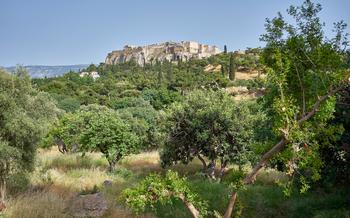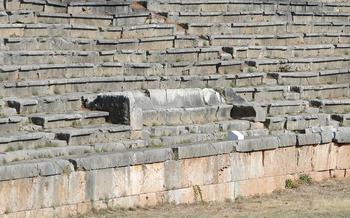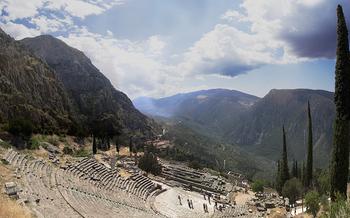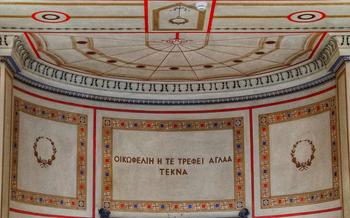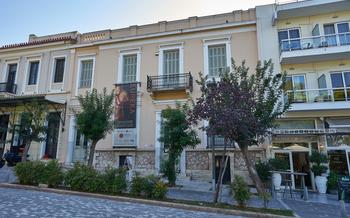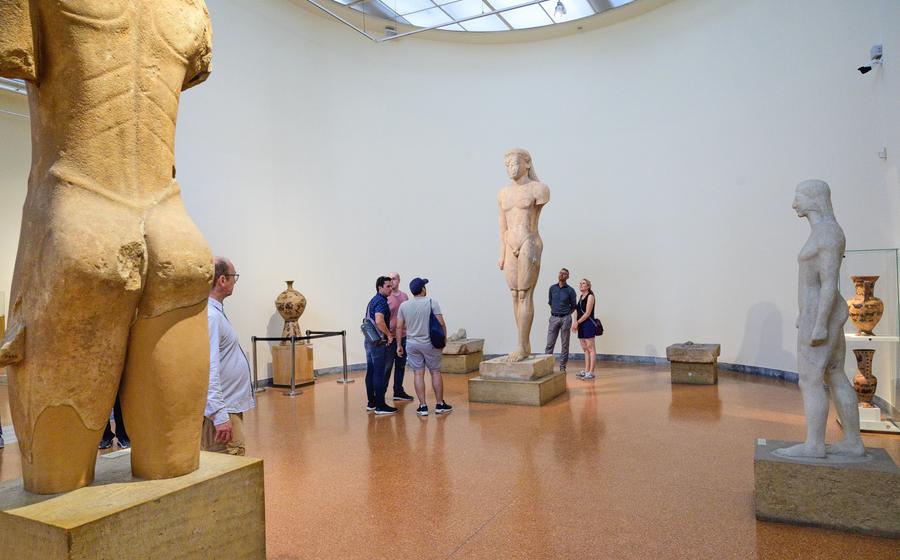
National Archaeological Museum of Athens
- National Archaeological Museum of Athens: A Journey Through Ancient Greek Civilizations
- Unveiling the Treasures of Greek History
- Admire the Exquisite Sculptures
- Explore the Realm of Greek Pottery
- Discover the Allure of Jewelry and Metalwork
- Delve into the World of Ancient Frescoes
- Unravel the Secrets of Everyday Objects
- Take a Break in the Museum's Garden
- Engage with Interactive Exhibits
- Explore Temporary Exhibitions
- Attend Lectures and Workshops
- Connect with the Museum's Online Resources
- Plan Your Visit: Essential Information
- Insider Tip: Unveiling Hidden Gems
National Archaeological Museum of Athens: A Journey Through Ancient Greek Civilizations
The National Archaeological Museum of Athens stands as a testament to the enduring legacy of ancient Greek civilization. Founded in 1829, it houses one of the world's most comprehensive collections of artifacts spanning the entirety of Greek history, from the Neolithic era to the Roman period. Its significance extends far beyond Greece's borders, making it a must-visit destination for anyone seeking to understand the roots of Western civilization.
The museum's grand neoclassical building, designed by German architect Ludwig Lange, is a sight to behold in itself. Its imposing façade, adorned with intricate sculptures, sets the stage for the treasures that lie within. Inside, visitors are greeted by a vast array of exhibits, arranged chronologically and thematically, taking them on a journey through the evolution of Greek art and culture.
From the awe-inspiring sculptures of the Archaic period to the delicate pottery of the Classical era, each artifact tells a story of the ingenuity, creativity, and craftsmanship of the ancient Greeks. The museum's collection is not merely a display of objects; it is a testament to the enduring power of human expression and the timeless beauty of ancient Greek art.
Unveiling the Treasures of Greek History
The National Archaeological Museum of Athens houses a treasure-trove of artifacts that narrate the rich history of ancient Greece. Among the highlights of the collection is the renowned Mask of Agamemnon, a golden funerary mask discovered in the 1870s at the site of Mycenae. This exquisite mask, with its intricate repoussé decoration, is believed to date back to the 16th century BC and is an iconic symbol of the Mycenaean civilization.
Another must-see artifact is the Antikythera Mechanism, an ancient analog computer dating back to the 2nd century BC. This remarkable device, discovered in 1901 in a shipwreck off the coast of the island of Antikythera, is considered to be the world's first mechanical computer. It was used to calculate the positions of the sun, moon, and stars, as well as to predict eclipses and other astronomical events.
The museum also boasts an impressive collection of sculptures, including the famous Kritios Boy, a life-size bronze statue from the 5th century BC that showcases the transition from the archaic to the classical style. The Charioteer of Delphi, a bronze statue from the 5th century BC, is another masterpiece that captivates visitors with its intricate details and expressive pose.
These are just a few of the many treasures that await visitors at the National Archaeological Museum of Athens. Each artifact tells a story, providing a glimpse into the lives, beliefs, and achievements of the ancient Greeks. The museum serves as a guardian of Greece's rich history, preserving and interpreting its cultural heritage for generations to come.
Admire the Exquisite Sculptures
The National Archaeological Museum of Athens houses an awe-inspiring collection of Greek sculptures, spanning various periods and styles. From the archaic era, with its rigid forms and enigmatic smiles, to the Hellenistic period, characterized by its graceful curves and intricate details, the museum's sculptures offer a captivating glimpse into the evolution of Greek sculptural art.
Among the highlights of the collection is the "Kritios Boy," a life-size statue of an athlete dating back to the 5th century BC. With its harmonious proportions and naturalistic pose, this sculpture epitomizes the transition from the archaic to the classical style. Another masterpiece is the "Charioteer of Delphi," a bronze statue of a charioteer and his quadriga, discovered at the sanctuary of Delphi. This remarkable work of art, dating back to the 5th century BC, showcases the technical virtuosity and artistic prowess of ancient Greek sculptors.
The museum's collection also includes impressive sculptures from the Hellenistic period, such as the "Winged Victory of Samothrace," a majestic marble statue of a goddess with outstretched wings, and the "Laocoön and His Sons," a dramatic sculpture depicting the struggle of a Trojan priest and his sons against sea serpents. These awe-inspiring works of art offer a testament to the skill and creativity of ancient Greek sculptors, who left an indelible mark on the history of art.
Explore the Realm of Greek Pottery
The National Archaeological Museum of Athens houses an extensive and diverse collection of Greek pottery, ranging from utilitarian vessels to elaborately decorated vases. These artifacts provide a fascinating glimpse into the everyday lives and artistic traditions of ancient Greece.
One of the highlights of the pottery collection is the Geometric style, which flourished from the 11th to the 8th century BC. Geometric pottery is characterized by its simple, linear designs, often featuring geometric patterns, spirals, and meanders. These vessels were used for a variety of purposes, including storage, cooking, and serving food.
Another notable style is Black-figure pottery, which emerged in the 7th century BC. Black-figure pottery features silhouettes of figures and scenes painted in black on a red background. The subjects of these paintings are often mythological, depicting gods, heroes, and monsters. Black-figure pottery was widely exported throughout the Mediterranean and beyond, and it played a significant role in the spread of Greek culture.
In the 6th century BC, Red-figure pottery replaced Black-figure as the dominant style. Red-figure pottery features figures and scenes painted in red on a black background, allowing for a greater degree of detail and realism. The subjects of Red-figure pottery are also more varied, including scenes from everyday life, as well as mythology and history.
The National Archaeological Museum's pottery collection is a treasure trove of information about ancient Greek culture. The vessels on display offer insights into the artistic traditions, technological developments, and social customs of ancient Greece. Whether you are interested in the history of art, archaeology, or simply the beauty of ancient artifacts, the pottery collection at the National Archaeological Museum of Athens is sure to impress.
Discover the Allure of Jewelry and Metalwork
The National Archaeological Museum of Athens boasts a dazzling array of jewelry and metalwork, showcasing the exceptional craftsmanship and artistry of ancient Greek artisans. From intricate gold and silver jewelry to finely crafted metal sculptures and coins, this collection offers a glimpse into the social and cultural significance of adornment in ancient Greece.
Among the highlights of the jewelry collection are exquisite necklaces, earrings, bracelets, and rings, adorned with precious stones and intricate designs. These pieces were not merely decorative; they often held symbolic or religious meaning, serving as talismans or offerings to the gods.
The museum also houses a remarkable collection of metal sculptures, ranging from small figurines to life-size statues. These sculptures, crafted from bronze, copper, and other metals, depict a variety of subjects, including gods, heroes, animals, and everyday objects. The intricate details and expressive poses of these sculptures attest to the skill and artistry of the ancient Greek metalworkers.
Finally, the museum's collection of ancient Greek coins provides a glimpse into the financial and economic systems of the ancient world. These coins, minted in various cities and regions, feature a diverse range of designs and symbols, offering insights into the political, religious, and cultural values of the time.
Delve into the World of Ancient Frescoes
The National Archaeological Museum of Athens houses a remarkable collection of ancient frescoes, offering visitors a vibrant glimpse into the art and culture of ancient Greece. These frescoes, which were once used to decorate the walls of palaces, temples, and private homes, provide invaluable insights into the lives and beliefs of the ancient Greeks.
One of the most famous frescoes in the museum is the "Fisherman Fresco" from Akrotiri on Santorini. This well-preserved fresco depicts a fisherman holding a net filled with fish, surrounded by a tranquil seascape. The vivid colors and intricate details of the fresco bring to life the beauty of the natural world and the daily activities of the ancient Greeks.
Another highlight of the museum's fresco collection is the "Procession Fresco" from the Palace of Knossos on Crete. This fresco depicts a procession of people, including musicians, dancers, and priests, carrying offerings to a goddess. The fresco's vibrant colors and lively depiction of movement offer a glimpse into the religious rituals and festivals of ancient Minoan civilization.
These frescoes, along with many others in the museum's collection, provide a unique window into the world of ancient Greek art and culture. They offer visitors the chance to see how the ancient Greeks depicted their world and to gain a deeper understanding of their beliefs, customs, and daily lives.
Unravel the Secrets of Everyday Objects
Beyond the grand sculptures and intricate pottery, the National Archaeological Museum of Athens houses a fascinating collection of everyday objects that provide a glimpse into the practical aspects of ancient Greek life. These humble artifacts, ranging from tools and utensils to household items and toys, offer valuable insights into the daily routines and technologies of the ancient Greeks.
From simple cooking pots and grinding stones to intricate bronze tools, the museum's collection showcases the ingenuity and craftsmanship of ancient artisans. Visitors can marvel at the intricate designs of oil lamps, the delicate handles of bronze strigils used for scraping oil and dirt from the body, and the sophisticated mechanisms of ancient locks and keys.
The museum also houses a collection of well-preserved textiles, offering a rare glimpse into the fashion and clothing of the ancient Greeks. From finely woven tunics and cloaks to intricately embroidered belts and jewelry, these textiles provide a tangible connection to the personal lives of people who lived thousands of years ago.
These everyday objects, often overlooked amidst the more famous sculptures and pottery, offer a unique perspective on ancient Greek culture. They reveal the practicalities of daily life, the technologies and innovations that shaped it, and the human stories behind the grand monuments and works of art that have come to define this ancient civilization.
Take a Break in the Museum's Garden
Amidst the grandeur of the National Archaeological Museum of Athens, a tranquil oasis awaits visitors seeking respite from the captivating journey through ancient Greek history. Step into the museum's garden, a haven of serenity where sculptures and mosaics bask amidst lush greenery, creating a sanctuary of peace and reflection.
As you stroll along the garden paths, let the gentle rustling of leaves accompany your thoughts, allowing the tranquility of nature to soothe your senses. Take a moment to pause by the ancient statues, their weathered surfaces whispering tales of bygone eras. Marvel at the intricate mosaics, their colorful tesserae forming vibrant patterns that seem to dance in the sunlight.
In the heart of the garden, a fountain gently cascades, its soothing melody providing a soundtrack for contemplation. Here, you can rest your weary feet and let your mind wander, savoring the beauty of your surroundings.
The museum's garden is not merely a resting spot; it is an extension of the museum's narrative, a place where the past and present harmoniously coexist. As you sit in the shade of ancient olive trees, let the spirit of antiquity envelop you, connecting you to the rich history that permeates every corner of this sacred space.
Whether seeking a moment of respite or a place to gather your thoughts, the National Archaeological Museum of Athens' garden beckons you to immerse yourself in its tranquility, allowing the wonders you've seen inside the museum to resonate within you.
Engage with Interactive Exhibits
The National Archaeological Museum of Athens embraces innovation by incorporating interactive exhibits that enhance the visitor experience and make ancient Greek history and culture more accessible and engaging for visitors of all ages. These exhibits employ state-of-the-art technology to create immersive and educational experiences.
Multimedia presentations bring ancient artifacts to life, allowing visitors to explore them in intricate detail. Touchscreens and interactive displays invite visitors to engage with the museum's collection, providing in-depth information and stories behind the artifacts.
Hands-on activities, such as virtual reality simulations and 3D modeling workshops, offer a unique and interactive way to learn about ancient Greek culture. These activities engage multiple senses, creating a memorable and immersive experience that complements the traditional museum displays.
The National Archaeological Museum of Athens recognizes the importance of embracing technology to cater to the evolving needs of visitors. By integrating interactive exhibits, the museum not only educates and informs but also inspires and captivates, leaving a lasting impression on visitors of all ages.
Explore Temporary Exhibitions
The National Archaeological Museum of Athens is not just a static repository of ancient artifacts; it is a dynamic institution that constantly evolves and engages with its visitors through a vibrant program of temporary exhibitions. These exhibitions showcase special collections, collaborations with other institutions, and innovative approaches to interpreting Greek history and culture.
Temporary exhibitions offer a unique opportunity to see rare and exceptional artifacts that may not be on permanent display. They often focus on specific themes, periods, or regions of ancient Greece, allowing visitors to delve deeper into the complexities of this fascinating civilization. Past exhibitions have explored topics as diverse as the Minoan civilization, the art of ancient Cypriot cities, and the influence of Alexander the Great.
By attending temporary exhibitions, visitors can gain new perspectives on ancient Greece and discover new aspects of its rich history and culture. These exhibitions also provide a platform for emerging scholars and artists to showcase their work and contribute to the ongoing dialogue about the significance of ancient Greece in the modern world.
To make the most of your visit, be sure to check the museum's website or social media platforms for information about current and upcoming temporary exhibitions. These exhibitions often have limited runs, so it is essential to plan your visit accordingly to avoid missing out on these special opportunities.
Attend Lectures and Workshops
Beyond exploring the museum's collection, visitors can immerse themselves in the world of ancient Greece through a rich program of educational events. The National Archaeological Museum frequently hosts lectures, workshops, and conferences led by renowned experts in the field of archaeology and ancient Greek history. These events offer unique opportunities to delve deeper into specific topics, gain insights from leading scholars, and engage in discussions with fellow enthusiasts.
Whether you're a history buff, an aspiring archaeologist, or simply curious about the ancient world, the museum's educational programs provide a platform for learning and exploration. Participate in interactive workshops, where you can handle replicas of artifacts, decipher ancient inscriptions, or learn about the latest archaeological discoveries. Attend lectures by renowned scholars, who share their expertise on topics ranging from Greek mythology to the history of the Olympic Games.
These events not only enhance your understanding of the museum's collection but also foster a sense of community among those passionate about ancient Greek culture. By engaging with experts and fellow learners, you'll gain a deeper appreciation for the richness and complexity of the ancient Greek world.
Connect with the Museum's Online Resources
The National Archaeological Museum of Athens embraces the digital age, offering a range of online resources that extend the museum experience beyond its physical walls. Its user-friendly website serves as a gateway to the museum's vast collection, featuring virtual tours, online exhibits, and educational resources.
Through the museum's website, you can embark on a virtual journey through its galleries, exploring highlights of the collection in stunning detail. These virtual tours provide a comprehensive and immersive experience, allowing you to navigate the museum's spaces and zoom in on artifacts as if you were there in person.
The museum's online exhibits delve deeper into specific themes and topics, showcasing rare artifacts, unpublished research, and behind-the-scenes insights. These digital exhibitions offer a unique opportunity to explore the museum's collection in greater depth and gain a deeper understanding of ancient Greek history and culture.
For those seeking educational resources, the museum's website provides a treasure trove of information. From downloadable lesson plans and interactive activities to scholarly articles and research papers, the museum's online resources cater to students, educators, and lifelong learners alike.
By connecting with the National Archaeological Museum of Athens online, you can continue your exploration of ancient Greece from anywhere in the world. Whether you're planning a future visit, revisiting your favorite artifacts, or simply seeking knowledge, the museum's digital resources offer a wealth of information and inspiration.
Plan Your Visit: Essential Information
Practical information is essential for a seamless and enjoyable visit to the National Archaeological Museum of Athens. Admission fees are reasonable and offer reduced rates for students, seniors, and families. The museum's hours of operation vary depending on the season, so it's advisable to check their website or call ahead to confirm. Accessibility is a priority, with wheelchair ramps, elevators, and designated seating areas throughout the museum.
Getting to the museum is convenient, as it's situated near the Acropolis metro station. For those who prefer driving, there's limited parking available in the surrounding area, but it's advisable to arrive early or consider alternative transportation options.
Enhancing your visit with a delightful meal or coffee break is easy, as there are several restaurants and cafes nearby. Indulge in traditional Greek cuisine or grab a quick bite to refuel before continuing your exploration of the museum's treasures.
Insider Tip: Unveiling Hidden Gems
Beyond the renowned masterpieces, the National Archaeological Museum of Athens holds a treasure trove of hidden gems waiting to be discovered. Venture off the beaten path to find lesser-known artifacts that offer unique insights into ancient Greek culture. In a quiet corner of the Bronze Age collection, uncover a delicate gold diadem adorned with intricate floral motifs. This exquisite piece, often overlooked amidst the larger exhibits, reveals the exceptional craftsmanship of ancient Greek goldsmiths.
In the Sculpture Gallery, seek out the enigmatic "Mourning Athena," a poignant marble statue that captures the goddess in a moment of sorrow. Her serene expression and flowing drapery convey a depth of emotion that sets her apart from other, more idealized depictions of Athena. This hidden gem invites visitors to contemplate the complexities of the Greek pantheon and the human emotions they embodied.
Another overlooked treasure lies within the vast collection of pottery. Among the rows of vases, find the "Siren Vase," a captivating vessel adorned with mythical creatures. The sirens, with their enchanting songs and alluring forms, symbolize the dangers of temptation and the allure of the unknown. This vase offers a glimpse into the rich mythology and storytelling tradition of ancient Greece.
Discover these hidden gems and more by exploring the museum's nooks and crannies. Take your time, wander aimlessly, and allow the unexpected to captivate you. The National Archaeological Museum of Athens rewards those who seek out its hidden treasures, offering a deeper understanding of the artistry, creativity, and storytelling prowess of ancient Greek civilization.
